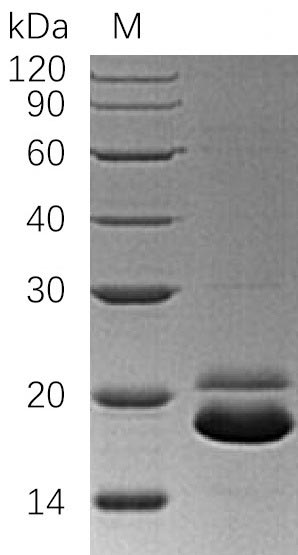Recombinant Human Tumor necrosis factor receptor superfamily member 10B (TNFRSF10B) is produced in mammalian cells and contains the 56-182 amino acid region of the protein. This partial protein includes a C-terminal 6xHis-tag, which simplifies purification and detection procedures. The protein achieves greater than 95% purity, as confirmed by SDS-PAGE analysis. Endotoxin levels remain below 1.0 EU/µg, determined through the LAL method. Biological activity appears robust, with an ED50 of 9.96 ng/ml when inhibiting TRAIL-mediated cytotoxicity in L-929 mouse fibroblast cells.
TNFRSF10B belongs to the tumor necrosis factor receptor superfamily and likely plays a key role in mediating apoptosis through its interactions with ligands like TRAIL. The protein seems integral to the extrinsic apoptotic signaling pathway, where it may help regulate cell death and survival mechanisms. This makes it an important target for researchers studying cancer and immune responses. Its function highlights why it has become a significant focus in research aimed at understanding and potentially manipulating apoptotic processes.
Potential Applications
Note: The applications listed below are based on what we know about this protein's biological functions, published research, and experience from experts in the field. However, we haven't fully tested all of these applications ourselves yet. We'd recommend running some preliminary tests first to make sure they work for your specific research goals.
1. TRAIL-TNFRSF10B Interaction Studies
This recombinant TNFRSF10B is confirmed to be functionally active (ED₅₀ 9.96 ng/ml in TRAIL inhibition) and suitable for binding studies. However, the partial sequence (56-182aa) represents only the extracellular domain and lacks the transmembrane and intracellular death domain, which may affect some aspects of TRAIL binding kinetics or receptor clustering. The mammalian expression ensures proper folding and glycosylation, but the C-terminal His-tag may cause steric effects near the ligand-binding interface. Researchers should validate binding parameters with full-length receptor controls.
2. Competitive Inhibition Assays for TRAIL Pathway Research
The protein is appropriate as a soluble decoy receptor for TRAIL inhibition studies, but the partial sequence may have a different affinity compared to membrane-bound full-length TNFRSF10B. The ED₅₀ provides a good starting point for dose-response studies, but researchers should validate that the inhibition mechanism (competitive vs. non-competitive) matches physiological receptor antagonism. The mammalian glycosylation supports native-like ligand interactions.
3. Antibody Development and Validation
This mammalian-expressed TNFRSF10B serves as a good antigen, but antibodies generated against this partial extracellular domain will not recognize intracellular epitopes or membrane-proximal regions. The C-terminal His-tag may induce tag-specific antibodies. Comprehensive validation should include testing against full-length, membrane-associated TNFRSF10B to ensure recognition of physiological receptor forms.
4. Protein-Protein Interaction Screening
The His-tag facilitates pull-down assays but may increase non-specific binding or miss interactions requiring the full-length receptor. While useful for identifying extracellular binding partners, researchers should validate novel interactions in cellular contexts with full-length TNFRSF10B. The partial sequence cannot identify interactions dependent on intracellular domains.
5. Structural and Biophysical Characterization Studies
The protein is suitable for structural studies of the extracellular domain, but the C-terminal His-tag may impede crystallization, and the partial sequence lacks the complete receptor architecture. For meaningful structural biology, tag removal and crystallization with TRAIL are recommended. The mammalian glycosylation ensures authentic ligand-binding domain structure.
Final Recommendation & Action Plan
This mammalian-expressed partial human TNFRSF10B (56-182aa) with a C-terminal His-tag is a functional tool for studying TRAIL-receptor interactions, but researchers should account for its soluble, truncated nature compared to full-length membrane receptors. For immediate use: 1) In binding studies, employ the ED₅₀ (~10 ng/ml) as a reference but validate affinity constants with full-length receptor controls; 2) For TRAIL inhibition assays, this soluble receptor works well as a decoy, but confirm physiological relevance in apoptosis assays; 3) When developing antibodies, this protein is suitable for extracellular domain antibodies, but complement with full-length receptor immunogens for comprehensive coverage; 4) For interaction studies, the tag facilitates screening but requires validation in cellular contexts; 5) For structural work, remove the His-tag and co-crystallize with TRAIL for meaningful insights. The mammalian expression ensures proper glycosylation, which is important for TRAIL binding, but the partial sequence cannot recapitulate full receptor clustering or signaling functions. Always include appropriate controls for tag-related artifacts and validate key findings with full-length TNFRSF10B in physiological systems.






